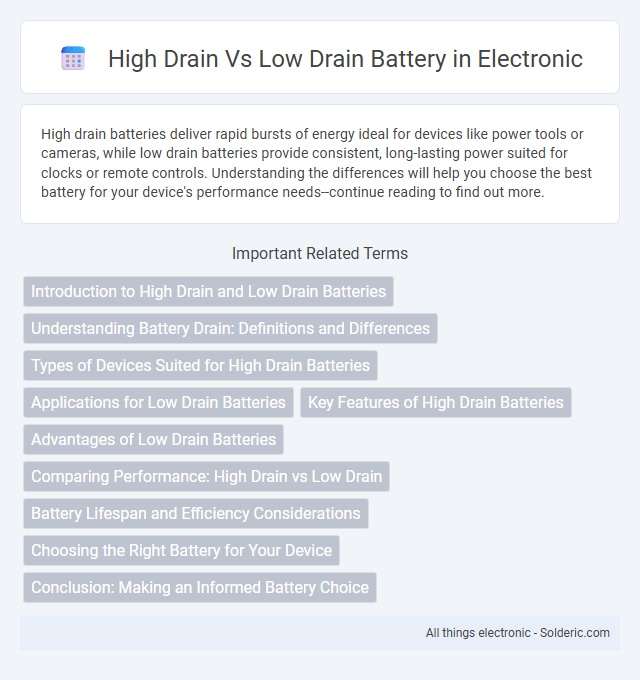High drain batteries deliver rapid bursts of energy ideal for devices like power tools or cameras, while low drain batteries provide consistent, long-lasting power suited for clocks or remote controls. Understanding the differences will help you choose the best battery for your device's performance needs--continue reading to find out more.
Comparison Table
| Feature | High Drain Battery | Low Drain Battery |
|---|---|---|
| Purpose | Supports devices with high current consumption | Suitable for devices with low current consumption |
| Current Output | High continuous and peak current output | Low to moderate current output |
| Battery Life | Shorter in high current use, optimized for quick power delivery | Longer lifespan under low current conditions |
| Applications | Power tools, drones, high-performance flashlights | Remote controls, clocks, smoke detectors |
| Cost | Generally higher due to advanced materials & construction | Lower cost, simpler construction |
| Internal Resistance | Low internal resistance for efficient power delivery | Higher internal resistance, not suited for bursts of power |
Introduction to High Drain and Low Drain Batteries
High drain batteries deliver high current output suitable for devices like power tools and vaping devices, ensuring efficient performance under heavy load. Low drain batteries provide steady, lower current output ideal for devices such as clocks, remote controls, and smoke detectors, optimizing long-term energy use. Understanding the difference helps you select the right battery for your device's power requirements and maximize its lifespan.
Understanding Battery Drain: Definitions and Differences
High drain batteries are designed to deliver a high current output consistently, making them ideal for devices with significant power demands like power tools, vaping devices, or high-performance flashlights. Low drain batteries provide a slower, steady discharge suitable for devices with minimal energy requirements such as remote controls, clocks, or calculators. Understanding the discharge rates and capacity differences helps in selecting the appropriate battery type to ensure optimal device performance and longevity.
Types of Devices Suited for High Drain Batteries
High drain batteries are ideal for devices requiring rapid bursts of high current, such as power tools, digital cameras, and vaping devices, which demand reliable and sustained energy output. These batteries maintain stable voltage under heavy loads, ensuring optimal performance and preventing voltage drops that can impair sensitive electronics. In contrast, low drain batteries are better suited for devices with low continuous power needs, like remote controls and clocks.
Applications for Low Drain Batteries
Low drain batteries are ideal for devices with minimal power consumption such as remote controls, clocks, and smoke detectors, where steady, long-term energy output is essential. These batteries maintain voltage over extended periods, ensuring reliable performance without frequent replacements. Your choice of a low drain battery supports cost efficiency and prevents unnecessary waste in low-power electronics.
Key Features of High Drain Batteries
High drain batteries deliver a high current output suitable for devices like power tools, flashlights, and high-performance electronics, ensuring consistent power under heavy load conditions. They typically feature a lower internal resistance, allowing rapid discharge without significant voltage drop, which improves efficiency and device performance. Your choice of a high drain battery enables longer run times and enhanced reliability in demanding applications compared to low drain alternatives.
Advantages of Low Drain Batteries
Low drain batteries excel in applications requiring consistent, long-lasting power with minimal current draw, making them ideal for devices like remote controls, clocks, and sensors. Their slower discharge rate extends battery life and reduces the frequency of replacements, saving you money and hassle over time. These batteries also produce less heat and maintain stable voltage, enhancing the safety and reliability of your low-power electronics.
Comparing Performance: High Drain vs Low Drain
High drain batteries deliver higher current output suitable for power-intensive devices such as digital cameras and power tools, ensuring consistent performance under heavy load. Low drain batteries are optimal for devices with minimal power demands, like clocks and remote controls, providing longer lifespan under steady, low usage. Choosing the right battery type directly influences Your device's efficiency and longevity based on its energy consumption profile.
Battery Lifespan and Efficiency Considerations
High drain batteries are designed to deliver bursts of significant current, making them ideal for devices like power tools or high-performance electronics, but they typically have a shorter overall lifespan compared to low drain batteries due to faster energy depletion. Low drain batteries provide a steadier and slower discharge rate suited for devices with consistent, low power demands such as remote controls and clocks, resulting in a longer lifespan and better efficiency over time. Choosing the appropriate battery type optimizes device performance and prolongs operational time by aligning discharge rates with power requirements.
Choosing the Right Battery for Your Device
High drain batteries are designed to deliver a rapid burst of energy, ideal for devices like digital cameras and power tools that require intense power demands. Low drain batteries provide a steady, long-lasting power supply, making them suitable for devices such as remote controls and clocks that consume energy slowly over time. Understanding your device's power requirements ensures you select a battery that maximizes performance and battery life for your specific needs.
Conclusion: Making an Informed Battery Choice
High drain batteries deliver higher current output, ideal for devices like power tools and high-performance electronics, while low drain batteries are suited for devices with minimal power requirements such as remote controls. Your choice should depend on the specific energy demands of your device to ensure optimal performance and battery life. Selecting the right battery type prevents premature failure and enhances overall device efficiency.
High drain vs Low drain battery Infographic

 solderic.com
solderic.com